(单词翻译:单击)
不同的文化往往有着截然不同的风俗习惯,然而古今中外的人对一样东西的企盼却是相同的,那就是好运。在东方文化中,红色、数字8、貔貅等常被视为好运的象征。而在西方英语文化中,又有哪些代表好运的文化符号呢?
People in most cultures believe in superstitions. From earliest times, the English, for instance, have believed in certain symbols and customs which could bring good fortune as well as ward off evil spirits. Old customs seldom die, so don't be surprised because some of these customs are still practiced daily in today's society.
大多数文化背景下的人都信一些迷信。比如,从古代开始,英国人就一直认为某些符号和习俗会带来好运、驱除邪灵。旧习俗很少会消亡,因此,如果当今社会仍然日复一日地遵循着这其中的一些习俗,也没什么好大惊小怪的。
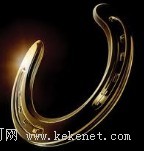
Horseshoe 马蹄铁
The horseshoe is considered a lucky symbol in English customs. It resembles the other symbols associated with good fortune in other cultures such as the crescent, half circle or "U". Crescent or "U" shapes are often said to be the symbol of fertility and also possesses power to ward off evil spirit. As it is made of iron and used for horses, horseshoes are also linked to strength and power. As such, combining all these signs of good luck, the horseshoe is regarded as a powerful device to bring fortune and keep evil spirits away. It is usually nailed to the front door to protect the household from uninvited visitors like witches and evils. However, the horseshoe must be placed in an upright "U" position so that the good fortune will be retained6) by the household.
在英语文化中,马蹄铁被看做是一种幸运符。它类似于其他文化中与幸运有关的标志,诸如新月、半圆或者是“U”形。新月或者“U”形往往被认为是丰饶肥沃的象征,并且还具有驱除邪灵的魔力。而马蹄铁由于是用在马身上的铁制品,因而又被人们看作与力量和权力有关。因此,集所有幸运象征于一身的马蹄铁就被人们看做是能招福辟邪的利器。人们通常将马蹄铁钉在房子的大门上,保护家人免受诸如巫师或者邪灵等不速之客的打扰。不过,钉的时候马蹄铁的U形口一定要朝上,只有这样,这家人才能留得住好运。
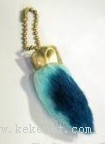
Rabbit's Foot 兔脚
In the old English custom, the hare (not rabbit) was said to have an evil eye), whose glance can only be countered by people who own a hare's hind foot. In the olden days, it was said that the warrior Queen Boadicea of Norfolk, East Britain, brought a hare with her to ensure luck in battle against the Roman Empire who had invaded her kingdom. This brought people to believe that the hare had miraculous) powers. However, the pagan) practice of worshiping the hare eventually stopped after most Britons were converted) to Christianity in the 6th century by the first Archbishop) of Canterbury. Nevertheless, many Britons carried hare's feet in their pocket or purse. Later, rabbits were introduced in Britain from the other European countries, and since rabbits can be caught more easily than hares, the rabbit's foot replaced the hare's foot as a lucky charm).
在古代的英语文化习俗中,据说野兔(不是家兔)长着一只邪眼,只有拥有一只野兔的后脚的人才能正视它的目光。据说,很久以前,来自英国东部诺福克的勇士博阿迪西亚女王在与入侵其王国的罗马帝国军队打仗时,就随身带着一只野兔来确保逢战必胜。这个传说令人们相信野兔具有不可思议的魔力。然而,到了公元6世纪,随着大多数不列颠人在坎特伯雷大主教的教化下改信基督教,这种异教徒对野兔的膜拜行为最终停止了。尽管如此,还是有很多英国人的口袋或者钱包中放着兔脚。后来,家兔从别的欧洲国家被引进到英国,由于家兔比野兔更容易获取,所以家兔的脚便取代野兔的脚成了幸运符。
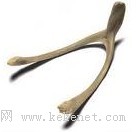
Wishing upon a wishbone is an ancient custom. It involves two people who would break the wishbone and the one with a bigger piece makes a wish. The wishbone is actually the forked bone from a fowl's breast, better known as the "furcula". In many cultures, fowls are regarded as special creatures which can bring luck and good fortune. The wishbone shape itself is good luck symbol of life and fertility.
向如愿骨许愿是一项古老的习俗。这个习俗是指两个人各执如愿骨的一端将其折断,得到较大块骨头的那个人就可以许个愿。其实,如愿骨就是取自家禽胸部的分叉状骨头,也就是人们所熟知的叉骨。在许多文化中,家禽被看做是能够带来吉祥与好运的特殊生灵。如愿骨的形状本身也是表示生命和多产的幸运符号。
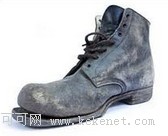
Old Boot 旧靴子
In ancient days, old boots or shoes were said to hold the good spirit and courage of their owners. Therefore, it was a common belief that an old boot was a good luck charm. For instance, if a fisherman caught himself an old boot instead of fish, it is believed that at the end of the day he would be able to catch and take home a huge amount of fish. In north England for instance, the wives of sailors would usually toss old boots or shoes at the departing ships to ensure their husbands' safe journey. Old boots were also left on the roofs of old houses to fend off evil spirits.
很久以前,据说旧的靴子或鞋子能够留存住其主人的美德和勇气。因此,过去人们通常认为旧靴子是一种幸运符。比如,如果一个渔夫钓上来的不是鱼而是一只旧靴子,人们就会认为,过完这一天的时候,这个渔夫将会捕获大量的鱼,满载而归。再比如,在英格兰北部,水手的妻子们通常会朝离港的船只扔旧靴子或者旧鞋子,以保佑自己的丈夫平平安安。人们还将旧靴子放在老房子的屋顶上来驱除邪灵。
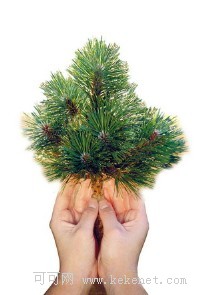
Wood 木头
Back in pagan times, trees were considered as sacred symbol of immortality. Touching the tree was a sign of respect to the gods after a favor has been requested, or thanks to the gods for a request that had been fulfilled. After the English embraced Christianity, the people retained their belief that wood is holy as Christ died on a wooden cross. People at that time wore wooden crucifixes16) and often touched them as a sign of penitence17). Even now, people who are superstitious will try to touch or knock on wood after gloating18), talking bad things about other people, making any rash19) statement of intent or so on, so that the action will get rid of any bad lucks during the day.
早在异教徒的时代,树就被视为是永生不朽的神圣象征。人们在祈求神灵庇佑之后,会触摸树以示对神灵的尊敬;或者是在祈求得到应验后,触摸树以表达对神灵的感激。在英国人皈依基督教之后,人们依旧坚信树是神圣之物,因为耶稣就是被钉死在木制十字架之上的。当时的人们佩戴木制的十字架,并且经常触摸它们以示忏悔。甚至现在,迷信的人还都会在沾沾自喜、讲别人坏话、说出任何轻率的言论或者是做出类似的事情时,试着去触摸木头或者敲打木头,期望这样做能够驱除一天之中所有的霉运。
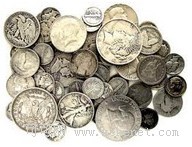
Coin 硬币
Coins, especially gold coins, were said to bring good fortune to the person who possessed them. Gold, like in any other culture, was always a symbol of wealth. In the past, "lucky" gold coins were turned into rings to be worn as a remedy20) for many types of illness. Sometimes, brides put them in a shoe to ensure a good married life. The English also dropped coins into wells to protect themselves from being bewitched and to make a wish in hope that their dreams would come true. This is due to the fact that people at the time believed there were good spirits who lived in the wells, fountains or springs.
据说硬币尤其是金币会给拥有它们的人带来好运。和在其他任何文化中一样,黄金一直都是财富的象征。在过去,人们会将“幸运”金币做成戒指戴在手上,当做治疗多种疾病的良方。有时候,新娘会把它们(金币)放进一只鞋子里,来祈求婚姻美满。英国人还会将硬币投入水井中,来保佑自己不会被人施予巫术,并且会许一个愿,期望着能够梦想成真。这一切都是因为:过去的人相信在水井、喷泉或者泉水里住着善良的神灵。
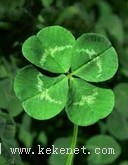
Four-leaf Clover 四瓣三叶草
Clover is actually a type of wild plant with flowers shaped like cotton balls and usually has three leaves on each stem. In fact it is very rare to find a four-leaf clover. It is believed that to accidentally find a four-leaf clover is a sign of good luck. Moreover, the shape of four-leaf clover resembles the symbol of the crucifix. There is also an English saying "to live in clover" which basically means "to have enough money to be able to live comfortably".
三叶草实际上是一种野生植物,它的花朵形状如同棉花球,通常在每一支梗上有三片叶子。事实上,四个瓣的三叶草是非常罕见的。人们相信,偶然发现四个瓣的三叶草是一种幸运的象征。而且,四瓣三叶草的外形和十字架相似。英语中还有一句谚语叫做“住在三叶草里”,其基本意思就是“拥有足够多的钱,能够十分安逸地生活”。


